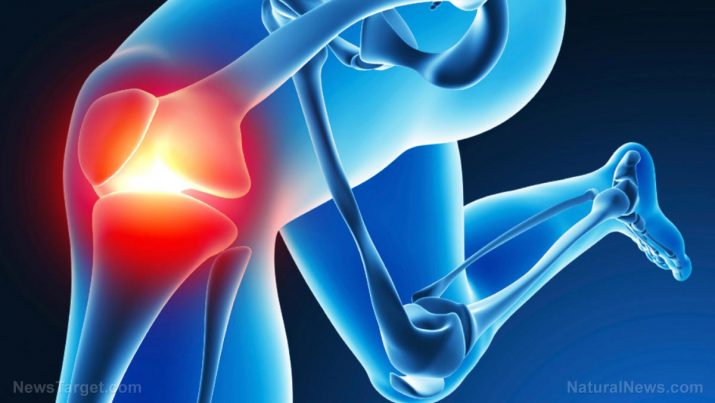
Osteoarthritis – causes, side effects and treatments at NaturalPedia.com
Wednesday, May 30, 2018 by Janine Acero
http://www.naturalpedia.com/osteoarthritis-causes-side-effects-and-treatments-at-naturalpedia-com.html

Osteoarthritis (OA) refers to joint inflammation due to cartilage degeneration. Cartilage is the tissue that covers the ends of bones in a joint. Healthy cartilage absorbs the shock of movement. When you lose cartilage, your bones rub together. Over time, this rubbing can permanently damage the joint.
OA is the most common form of arthritis. It is sometimes called degenerative joint disease or “wear and tear” arthritis. It commonly occurs in the hands, hips, and knees. It usually develops slowly and gets worse over time. OA causes pain, stiffness, and swelling, and can lead to disability.
OA commonly affects women more than men, after the age of 50 years, but it can also can affect younger people after a traumatic injury.

Known symptoms, risk factors for osteoarthritis
The following are the symptoms of osteoarthritis, which mainly affects the joints:
- A grating or crackling sound or sensation
- Limited range of movement
- Pain or aching
- Stiffness
- Swelling
The individual may also notice that:
- The pain and stiffness worsen after not moving the joint for a while
- The joints feel warm and tender
- There is a loss of muscle bulk
Developing OA is highly likely with the following risk factors:
- Joint injury or overuse — e.g., constant knee-bending
- Age — Individuals at 50 years of age are more prone to OA
- Gender — OA more commonly occurs in women
- Obesity — Extra weight puts more pressure on the joints
- Genetics — OA tends to run in families
- Race — Some Asian populations have lower risk for OA
Body systems harmed by osteoarthritis
OA can cause joint pain, stiffness and swelling, as well as reduced joint function and disability. It can restrict a person’s ability to do daily tasks. In some cases, affected individuals are not able to work completely. Severe cases may require joint replacement surgery, particularly for knee or hip OA.
Food items or nutrients that may prevent osteoarthritis
Affected individuals will be encouraged to maintain a healthy weight to reduce the pressure on the joints.
Studies have suggested that some types of OA respond positively to a diet high in flavonoids and antioxidants, which are essential anti-inflammatory nutrients found in fruits and vegetables.
Eating foods high in the following may help provide relief from OA symptoms by reducing inflammation and swelling:
- Vitamin C — Guavas, bell peppers, kiwifruit, strawberries, oranges, papayas, broccoli, tomatoes, snow peas, and kale
- Vitamin D — Fatty fish (tuna, mackerel, and salmon), cheese, beef liver, egg yolks
- Vitamin E — Spinach, almonds, sunflower seeds, avocados, shellfish (shrimp, crayfish, lobster and oysters), rainbow trout, olive oil, broccoli, gourds (pumpkin and squash), and kiwifruit
- Beta-carotene — Orange- and yellow-colored produce, like carrots, squash, apricots and cantaloupes
- Omega-3 fatty acids — Soybeans, walnuts, salmon, mackerel, sardines, chia seeds, flaxseeds
Treatments, management plans for osteoarthritis
There is no cure for OA; treatment only relieves symptoms and maintain joint movement. Treatment involves a combination of therapies, which may include:
- General exercise/physical activity
- Medications, like prescription drugs and over-the-counter painkillers (take note of the associated adverse side effects)
- Physical therapy with muscle-strengthening exercises
- Weight loss
- Practicing proper posture
- Supportive devices such as crutches or canes
- Surgery (if other treatment options have not been effective)
In addition to medical treatment, people with OA can manage their condition with self-management strategies proven to reduce pain and disability, so they can pursue the activities important to them.
Where to learn
- Boron, a trace mineral, found to be a potent cancer-preventing substance
- Cannabis compound relieves pain from osteoarthritis
- New Study Confirms Yoga Offers Arthritis Relief
- Dietary fiber found to reduce osteoarthritis knee pain in first-ever study of its kind
- Tai Chi found to significantly improve knee movement and flexibility in osteoarthritis patients
Summary
Osteoarthritis (OA) refers to joint inflammation due to cartilage degeneration. It is the most common type of arthritis.
OA is the most common form of arthritis, which commonly occurs in the hands, hips, and knees. OA can cause pain, stiffness, and swelling, and can lead to disability.
Sources include:
Tagged Under: Tags: Osteoarthritis





